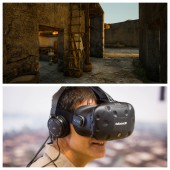Ullastret 250BC at Iberian Town Virtual heritage by Burzon Comenge |
Home > Winners > #54109 |
 |
|
||||
| DESIGN DETAILS | |||||
| DESIGN NAME: Ullastret 250BC at Iberian Town PRIMARY FUNCTION: Virtual heritage INSPIRATION: The inspiration was not only to divulge the archaeological site of Ullastret, it was to get the user to experience it. We achieved that applying the virtual reality and the immersive room technologies to the Iberian art. The content of the recreation captures compleately the essence of the Ullastret on 250 BC. This is the moment when there is more data available and therefore allows a more accurate recreation. UNIQUE PROPERTIES / PROJECT DESCRIPTION: The archaeological site of the Iberian town of Ullastret (Baix Emporda - Catalonia) is considered the biggest and most important of this period in Catalonia. Now thanks to the new technologies and the virtual reality and the immersive room of the museum, the audience can walk through the streets and inside the houses. This installation transports the user to 250 BC in a totally immersive and interactive way. OPERATION / FLOW / INTERACTION: The immersive room is in the museum of the archaeological site of Ullastret. It is like a cinema room, but it has three screens: a frontal one and two lateral ones. The position of those three screens allows the user to have an almost 360 degrees vision. The virtual reality installation is in the Archaeological Museum of Catalonia (MAC). With the virtual reality we transport the user to the middle of the Iberian city of Ullastret. PROJECT DURATION AND LOCATION: The production of the project lasted two years. It was made in Igualada, Barcelona and finally in Ullastret. |
PRODUCTION / REALIZATION TECHNOLOGY: The first step of the project was to understand and analyse the documents that the archaeologists facilitate to us. Afterwards we used all that information to visualise the 2D and 3D sketches. Once the archaeologists approved the sketches we built a final 3D model applying textures and materials to each of the elements. Once we had the whole 3D model finished we imported it to a video game creation engine in order to create different video games to be used in the immersive room to create an emotional journey through the virtual reality. SPECIFICATIONS / TECHNICAL PROPERTIES: The virtual reality was generated with a video game software called Unreal Engine. The virtual experience uses the HTC Vive glasses. The immersive room has three projectors Christie that project the images on three walls of the room. TAGS: Heritage, Iberian art, virtual reality, immersive room RESEARCH ABSTRACT: The Burzon Comenge studio is expert in new technologies, but the team didn’t have the proper knowledge regarding the Iberian culture when starting the project. They had to learn and fully understand who the Iberians were, how did they live and how they were. The experts from the archaeological site helped them go through the learning process. During the whole project there was a constant aim of research and investigation in a theoretical and in a technological level. CHALLENGE: The main challenge was to convert the viewer into a user that could not only see, but experience how the Iberian town of Ullastret was in detail. We didn’t stop there, we wanted the user to be able to understand from the general geographical location to small items like the ceramics of the time. ADDED DATE: 2017-02-20 19:43:33 TEAM MEMBERS (8) : Art direction: Albert Burzon, 3D Artists: Albert Burzon, Ester Comenge, Albert Reguero and Oscar Jimenez, Programmer: Vysion360, Scriptwriter: Jaume Grau, Sound: Fernando Novillo, Direction: Gabriel de Prado, Coordination: Albert Sierra and Isis Ruiz and Scientific advisor: Ferran Codina IMAGE CREDITS: Image #1#2#3#4#5: Albert Burzon. Video credits: Video and edition: Albert Burzon. |
||||
| Visit the following page to learn more: http://goo.gl/dVA8Dt | |||||
| AWARD DETAILS | |
 |
Ullastret 250bc At Iberian Town Virtual Heritage by Burzon Comenge is Winner in Cultural Heritage and Culture Industry Design Category, 2016 - 2017.· Press Members: Login or Register to request an exclusive interview with Burzon Comenge. · Click here to register inorder to view the profile and other works by Burzon Comenge. |
| SOCIAL |
| + Add to Likes / Favorites | Send to My Email | Comment | Testimonials | View Press-Release | Press Kit |







